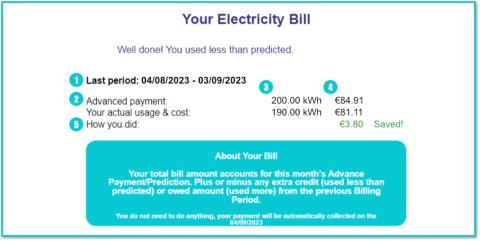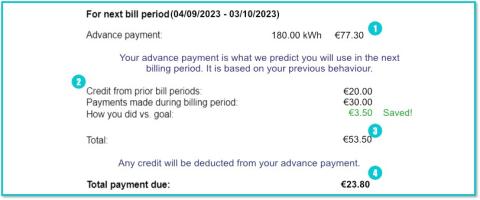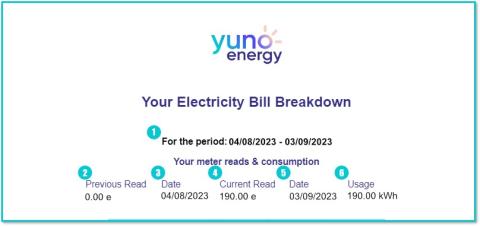Your Yuno Energy Electricity Bill Explained
You receive your monthly electricity bill via the Yuno Energy app 24 hours before your payment date. We've put together a simple explainer to help you understand your bill.
Page 1 of your Bill

1. Name and Address
Your name and address as they appear on your Yuno Energy account.
2. Account Details
The details of your account and plan.
Account Number: Your Yuno Energy account number.
MPRN: An 11-digit number that identifies your property's electricity supply.
MCC: The Meter Configuration Code indicates your electricity meter type.
DG: Your account will either be DG1 (Urban) or DG2 (Rural).
Plan Name: The name of the Yuno Energy plan.
Issue Date: The day this bill was issued.
Invoice Number: A unique number for this bill.
Previous Billing Period

This section summarises any difference between your predicted and total actual usage at the end of the last period.
1. Previous Period
The start and end dates of the previous billing period. New billing periods begin on the date your bill is issued.
2. Advanced Payment
The amount you paid at the start of your previous billing period. It was based on how much electricity we predicted you would use during the billing period.
3. Usage
How many Kilowatt-hours (kWh) we predicted you would use and how many you actually used.
4. Cost
The cost of your actual total electricity usage (see No.3).
5. How you did
The difference between your predicted usage and your actual usage. If you used less than predicted, we'll deduct the extra credit from this bill. If you used more, this amount will be added.
You'll find a complete breakdown of the previous billing period on Page 2 of your bill (below).
Next Billing Period

This section covers the calculation of the amount due for the upcoming billing period.
1. Advance Payment
The amount owed based on your predicted usage.
2. Factors Affecting Payment
Any positive or negative amount applied to the current payment.
Credit carried forward from a previous billing period taken off this payment.
Ad-hoc payments made during Billing Periods towards your next bill.
Any difference between your predicted and actual usage from the previous period applied to this bill.
3. Total
The combined total of the above figures applied to your Advance Payment. Making payments during the current billing period and using less electricity than predicted will help reduce your costs.
4. Total Payment Due
This is the amount charged to the debit or credit card on your account on billing day. It accounts for your Advance Payment (1) and Total (3).
Page 2 of your Bill

This page provides more detailed information about the previous billing period.
1. Billing Period
The date range of the previous billing period. This can be anywhere between 15 and 45 days for your first bill. Thereafter, your billing periods usually last 30 days.
2. Start Read
This is the meter reading from the start date of the billing period. It will always show as zero on your first bill. It will also confirm if the reading was estimated (e), actual (a), or customer-provided (c).
3. Start Read Date
The date of the meter read.
4. End Read
The meter reading from the end of the billing period.
5. End Read Date
The date the meter read in part (4) was taken.
6. Energy Usage
The difference between the reads at the start (2) and the end (4) of the billing period.

1. Electricity Charges
This charge is based on the amount of electricity used in kilowatt-hours (kWh) and your unit rate.
2. Standing Charge
All energy suppliers apply a daily Standing Charge towards the cost of providing and maintaining your electricity supply.
3. PSO Levy
The government applies the Public Service Obligation Levy (PSO) to all energy customers to support renewable energy generation in Ireland. It has been set to zero for 2023-24.
4. Units
For electricity, this is the volume of kilowatt-hours (kWh) used. With Standing Charges, it's the number of days in your billing period.
5. Rate
The rate charged per unit (kWh and Standing Charge).
6. Amounts
This individual totals for columns 1, 2 and 3.
7. Total Ex. VAT
This combined total of the rows above ( excluding VAT).

1. Total Ex. VAT
The same as No.7 from the previous section.
2. VAT Rate
The percentage rate of VAT.
3. Total Including VAT
The actual total cost including VAT
4. Advance Payment
The amount you paid at the start of the billing period.
5. How You Did
The difference between No.3 and No.4. If No.3 is less than No.4, the remaining amount will be deducted from your next bill. If it's more, the difference will be added.
Enjoy certainty and peace of mind with our newest fixed-rate plan. With personalised insights, you can reduce your energy usage and spend less.
Electricity Variable
Put up to €633 back in your pocket with combined savings of €433* plus a €200 Welcome Bonus†.

More reasons to love this 12-month plan:
- Get daily updates on your predicted bill
- Review your usage in hours or days
- Track and manage everything in our app
- Your estimated annual bill is just €1,554
Stay one step ahead with our winter price freeze on gas and electricity.
You’ll need your email address, mobile number, MPRN or Eircode, and bank card.
Get in touch with us
Frequently asked questions
Find no-nonsense answers to common questions about the Yuno Energy service and app.